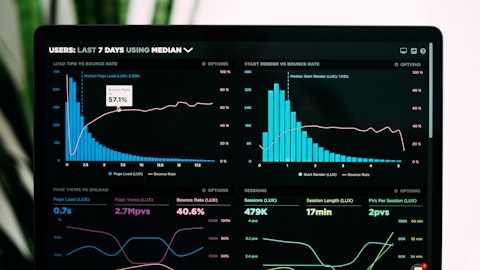Bill Peterson: Okay. Thanks. Thanks again.
Operator: Thank you. Our next question comes from the line of Alex Hacking from Citi. Please go ahead.
Alex Hacking: Yeah. Hi. Good morning and thanks for the call. So not sure if you can answer this, but on the cost side, cash costs right now is in the high $5,000. As we look out to next year in the second half of the year, if we’re back to a more normalized utilization rate of 70% or something. The best information that you have today like where would that cash cost be? Like I assume it’s somewhere in the $4,000, but I don’t know if it’s high $4,000, low $4,000. Any color would be appreciated. Thank you.
Marcel Kessler: Yeah. Thanks for the question, Alex. And I’ll start by saying it’s probably a little premature for us to be providing kind of detailed guidance or outlook on 2024, just given the fact that the commentary Jeremy provided around where we’re at in the commercial negotiation process. That process, obviously, will inform our production capital and cost programs for the next fiscal year. So what I will say though directionally speaking is, we are a heavy fixed cost business. Any incremental improvement in our overall utilization rate of our plans will bring down our cost meaningfully, as well as if you think about the underlying raw material costs, energy, things like that. We’ve commented on. Those are continuing to moderate as we’ve expected and we’d expect significant improvement of those elements of our cost structure heading into next year will be through most of the inventory that’s sitting on our balance sheet that’s high priced, so we’ll be in a much better cost position as we look out to next year.
The other thing, the only other comment I would make just on the cost today sitting in that high five number that you quoted. Don’t forget, in there, you’ve got about $375 of Seadrift cost that we’re carrying that doesn’t have any corresponding production associated with it. And so, as we restart Seadrift you naturally have those costs come out of the system.
Alex Hacking: Okay. Thanks. Makes sense. And then just to clarify, I guess on earlier comments, it sounds like you’re hoping for a higher utilization rate in the first half of next year compared to where we’ve been in the second half of this — in the second half of this year. Is that fair?
Marcel Kessler: Yeah. Again, without getting into specific kind of guidance, right, just given where we’re at in the commercial side. What I can say is we’re entering this year’s negotiation season with the opportunity to lock in significant volumes with our customers. We didn’t have that opportunity because of Monterrey a year ago, but we’re in that position today. We’ve meaningfully reduced kind of the operational risk associated with Monterrey during the current year and Jeremy commented on our ability to produce pins at multiple locations now. So we feel really good about the position we’re starting from on top of the fact, again broadening our commercial offerings to our customers. We think we present a compelling value proposition beyond just quality electrodes. So all of those things would lead us to be in a much stronger commercial position with the backdrop of the current macro environment.
Alex Hacking: Okay. Thanks. And I guess just one final question if I may. This is probably a dumb question, but I think in your prepared comments you talked about a carbon-neutral offering. I guess how does that work in a product that’s effectively made of carbon? Thanks.
Marcel Kessler: Yeah. So fair enough. That’s a good question. A good question, Alex. The — when we say carbon neutral, right, we’re really talking about CO2 equivalence, right? It’s — there’s carbon in trees and everything else that we want more of. But the carbon neutral electrode was really born out of a trend toward more environmentally responsible steelmaking. And our ability to do this is really facilitated by some of the investments that we’ve made over the past few years to limit our Scope 1, 2, and 3 emissions. These are investments that we’ve made in assets and systems to reduce our onsite generation of CO2 and sourcing portions of our power from carbon-free sources now. And so, we’ve been able to significantly drive down our carbon footprint and for any CO2 equivalent emissions that we can’t eliminate we’ll buy offsets for.
And so, this gives us an opportunity to lead the market in the introduction of a product like this. The product will of course be priced at a premium and as a result won’t be for everybody. But we do think that this is another step toward differentiating ourselves from some of our more price-focused competitors that we talked about.
Alex Hacking: Okay. Thanks. Makes sense. Thanks for the call.
Marcel Kessler: Thanks.
Operator: Thank you. Our next question comes from the line of Sophia Danziger from RBC Capital Markets. Please go ahead.
Marcel Kessler: Good morning.
Sophia Danziger: Good morning. Thanks for taking my question. The first one, I wanted to follow up on an earlier question that was asked by Bill here regarding the non-tech protected regions, flooding the market recognizing cheaper exports and how they’ve impacted pricing power. You spoke a little bit about the differentiation of your product and I think that’s a big part of the value proposition you’ve spoken about in the past. Maybe you can help us walk through a little further how we should think about that differentiation today. Is it not being valued the same by the market given some of the pricing pressure we’re seeing here now and slowdown of LTEs potentially on a go forward?
Marcel Kessler: Certainly. I would start by saying not all customers are created equal, right, and people have different concerns and, frankly certain mills run differently than other mills in terms of the stresses and strains they put on the product. So certain markets are able to take lower quality electrodes versus what are otherwise favored both in North America and Europe in many respects. But customers ultimately will make a decision around consumption rates versus ultimately the price that they have to pay for an electrode in — what’s being delivered. I would say in those markets today where they’re running at lower than kind of prime utilization rates. They’re not necessarily compensating for the higher quality, the lower consumption rate, and what we think is the value proposition of our product. But those markets where that is value, we certainly are getting that premium.



